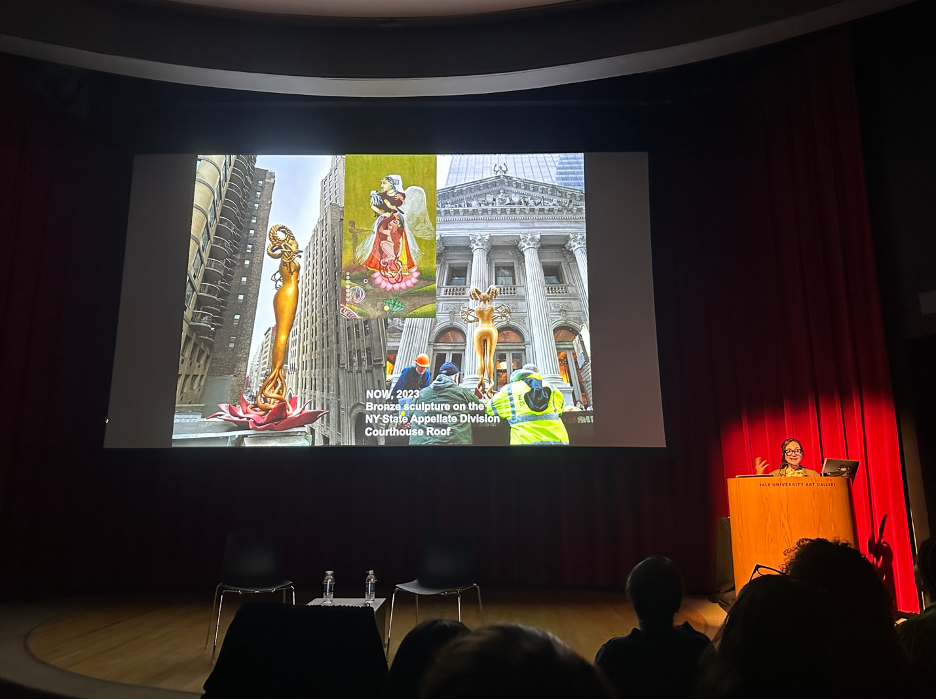
Zeyna Malik, Contributing Photographer
On Oct. 9, 2024, Shahzia Sikander, an Arts & Practitioner Fellow at the Yale Race, Indigeneity, and Transnational Migration Center spoke about her work at “Collective Endeavors and Future Behaviors,” an event hosted at the Yale University Art Gallery. Sikander’s lecture was followed by a discussion with Wendall K. Harrington, a professor at Yale’s David Geffen School of Drama, and an audience-led Q&A session.
Originally a specialist in miniature paintings, Sikander discussed her shift into the realm of sculpture. Though much of Sikander’s work engages with history, she’s wary of making art that glorifies it. Sikander calls her work an “anti-monument.”
“And I’d always called it an anti-monument, but because it was always small works on paper, nobody would use that language.”
Sikander relocated to the U.S. from Lahore, Pakistan, to pursue an MFA at the Rhode Island School of Design in the early 1990s. While working on a 2001 exhibition at the Morgan Library, she recognized a pressing limitation of her art: compared to paintings on canvas or sculptures, works on paper seldom saw the light of public display and were often confined to storage.
This encouraged Sikander to seek platforms beyond those offered by traditional institutions. Instead, she was determined to have her art engage directly with the public, outside the confines of galleries and museums.
In the U.S., she became increasingly aware of her tokenization as a South Asian visual artist in what she described as America’s “black-and-white” culture. This realization propelled her to find alternative forms of representation.
She asked herself, “How do I get out of this situation and find ways to put my work outside the institutional sort of systems or structures of the gallery or the institution like a museum?”
Sikander found the answer to this question when she walked out onto the streets of Manhattan and saw a vacant plinth on the roof of the courthouse of the Appellate Division of the First Department of the New York State Supreme Court, where a sculpture of Byzantine emperor Justinian once stood.
She soon replaced this empty space with her own sculpture: an eight-foot bronze sculpture, titled “NOW.” This work was part of her multimedia exhibition “Havah…to breathe, air, life,” which features another sculpture, “Witness,” located at Madison Square Park.
An eighteen-foot-tall golden female figure, “Witness” flaunts limbs that resemble intertwined roots. She appears untethered, suspended in the air, defying permanence.
“I was impressed when seeing the public sculptures by, firstly, her lyrical, two-dimensional style and three-dimensionality, monumentally so. Secondly, by the depth and formal dialogue that she presented across a busy Manhattan street.” said Kymberly N. Pinder, dean of the Yale School of Art.
Since its creation in 2023, “Witness” has been at the center of critical acclaim — and public outcry.
In February 2024, “Witness” moved to the University of Houston, where it became embroiled in controversy when a major anti-abortion organization in Texas alleged that it promoted pro-choice imagery and paid homage to the late Supreme Court Justice Ruth Bader Ginsburg, said Sikander during the event.
Facing pressure, the University of Houston canceled the opening and the artist talk, without providing an explanation to students. Such silence created room for misinformation and confusion, said Sikander.
It wasn’t until weeks later that signage with additional information about the sculpture was finally placed next to the piece.
“When you’re thinking in terms of public art, where people are going to see things without deliberately choosing to go to a museum, you need to think about how to make contact, and in what form, since the initial impulse is between the artist and the person,” said Harrington.
The sculpture would later be defaced when, in July 2024, a man climbed the 18-foot sculpture and decapitated its head with a hammer.
During her talk, Sikander explained how “Witness” was, indeed, a nod to Justice Ruth Bader Ginsburg, as well as previous female Supreme Court Justices. She pointed out the lace collar on the sculpture as a reference to the accessories Ginsburg and Sandra Day O’Connor — the first female Supreme Court Justice — had added to the traditional black judicial robe.
According to Sikander, the figure’s braided hair draws from African and Asian artistic traditions. The hair, shaped like ram’s horns, symbolizes resilience and wisdom, she said. The face of the sculpture, now-destroyed, was intended to be a composite of the faces of radical female poets, embodying a collective voice.
The artist continued and said that the vandalism was more than just an assault on the sculpture; it was an attack on the concepts of personal freedoms, expression and the visibility and voice of women.
She chose not to repair the damage, wanting to leave the sculpture in its beheaded state as a visible reminder of the violence that marks its history.
“I believe that rather than censoring or destroying art, we should embrace its ability to challenge our perspectives, to see beyond binaries, to engage with the complexities of identity, power and history,” said Sikander. “Witness’ is a testament to that challenge, and its defacement only strengthens its message.”
The Yale University Art Gallery is located at 1111 Chapel St.

